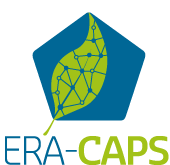An Effector- and Genomics-Assisted Pipeline for Necrotrophic Pathogen Resistance Breeding in Wheat
- Acronym EfectaWheat
- Duration 36
-
Project leader
James Cockram (Project leader), UK, National I of Agricultural Botany, Cambridge, funded by BBSRC
-
Other project participants
Lise Nistrup Jørgensen, DK, U Aarhus, Slagelse, funded by DASTI (now IFD)
Lorenz Hartl, Germany, Bayerische LA f Landwirtschaft, Freising, funded by DFG
Morten Lillemo, NO, Department of Plant Sciences, Aas, funded by RCN
Richard Oliver, AU, Curtin University, Perth, own funding
- Funding
- Total Granted budget ca. € 1.818.200
Abstract
| EfectaWheat is a partnership of five complementary institutes from the UK (NIAB), Germany (LFL), Denmark (AARHUS), Norway (NMBU) and Australia (CCDM, self-funded), as well as a subcontract to the UK governmental agency, FERA. The partners form a multidisciplinary team focusing on the economically important wheat leaf spot group (LSG) of necrotrophic pathogens: Parastagonospora nodorum (Pn, cause of Septoria nodorum blotch; SNB), Zymoseptoria tritici (Zt, Septoria tritici blotch; STB) and Pyrenophora tritici-repentis (Ptr, tan spot; TS). High-resolution wheat genetic mapping populations (available at NIAB and LFL) and high-density genotyping will be combined with effector-based tools, pathogen re-sequencing approaches (CCDM), and expertise in pathogen diagnostics, virulence assessment (LFL, AARHUS, FERA), and field pathotesting across all partner countries (NMBU, NIAB, AARHUS, LFL). These combine to deliver a genomics- and effector-based pipeline for the genetic dissection of LSG host-pathogen interactions in Europe. The unique positions of partners at the interface between crop research and translation ensure effective dissemination of project outputs to European agri-industry. This approach has been successfully implemented by CCDM for SNB and TS in Australia, where it is forecasted to reduce losses by ~€100m per annum by 2020. This project will extend the approach to Europe. Specifically, it will: (1) Establish relative impact of LSG pathogens in target EU countries using molecular approaches. (2) Identify new TS and SNB effectors. (3) Determine the effector profile of Pn and Ptr isolates and the sensitivity of cultivars to effectors. (4) Screen TS, SNB and STB effectors against high-resolution wheat germplasm resources. (5) Resolve multiple LSG effector and field resistance QTLs at high-resolution. (6) Establish prevention and management strategies against multiple LSG pathogens. (7) Deliver tools (effectors and markers) for LSG resistance breeding to EU breeders and researchers. All resources will be made available to the research and industrial communities to facilitate practical exploitation. To help ensure effective uptake of information and data, dissemination activities will focus principally around: (1) Existing dissemination infrastructures and materials provided by project partners, aimed at private breeding companies, agronomists and growers. (2) Existing bi-lateral relationships between partner institutes and wheat breeding companies. (3) On-farm: demonstration and presentation at NIAB Innovation Farm. (4) On-line: via the project web-site, to include all data, or links to data, as it emerges. |
